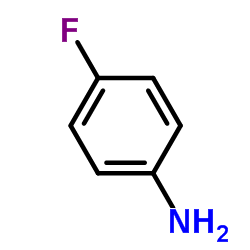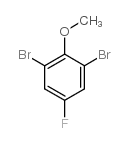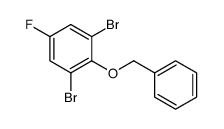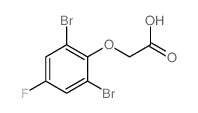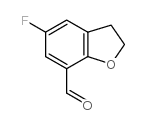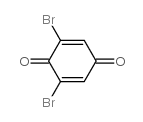344-20-7
| Name | 2,6-dibromo-4-fluorophenol |
|---|---|
| Synonyms |
2,5-BIS(TRIFLUOROMETHYL)BENZYL AMINE
4-Fluor-2.6-dibrom-1-hydroxy-benzol EINECS 206-451-1 MFCD00002317 2,6-dibromo-4-fluoro-phenol 2,6-Dibrom-4-fluor-phenol 2,6-dibromo-4-flurophenol Phenol,2,6-dibromo-4-fluoro Phenol, 2,6-dibromo-4-fluoro- 2,6-Dibromo-4-fluorophenol |
| Density | 2.2±0.1 g/cm3 |
|---|---|
| Boiling Point | 219.5±35.0 °C at 760 mmHg |
| Melting Point | 55-57°C |
| Molecular Formula | C6H3Br2FO |
| Molecular Weight | 269.894 |
| Flash Point | 86.5±25.9 °C |
| Exact Mass | 267.853455 |
| PSA | 20.23000 |
| LogP | 3.68 |
| Vapour Pressure | 0.1±0.4 mmHg at 25°C |
| Index of Refraction | 1.616 |
| Storage condition | 2~8℃ |
|
2,6-Dibromo-4-fluorophenol
Revision number: 5
SAFETY DATA SHEET Section1. IDENTIFICATION Product name:2,6-Dibromo-4-fluorophenol Revision number:5 Section2. HAZARDS IDENTIFICATION GHS classification PHYSICAL HAZARDSNot classified HEALTH HAZARDS Acute toxicity (Oral)Category 4 Category 4 Acute toxicity (Dermal) Acute toxicity (Inhalation)Category 4 Category 2 Skin corrosion/irritation Serious eye damage/eye irritationCategory 2A Not classified ENVIRONMENTAL HAZARDS GHS label elements, including precautionary statements Pictograms or hazard symbols Signal wordWarning Harmful if swallowed, in contact with skin or if inhaled Hazard statements Causes skin irritation Causes serious eye irritation Precautionary statements: Avoid breathing dust/fume/gas/mist/vapours/spray. [Prevention] Use only outdoors or in a well-ventilated area. Do not eat, drink or smoke when using this product. Wash hands thoroughly after handling. Wear protective gloves and eye/face protection. [Response]IF INHALED: Remove victim to fresh air and keep at rest in a position comfortable for breathing. Call a POISON CENTER or doctor/physician if you feel unwell. IF SWALLOWED: Call a POISON CENTER or doctor/physician if you feel unwell. Rinse mouth. IF IN EYES: Rinse cautiously with water for several minutes. Remove contact lenses, if present and easy to do. Continue rinsing. If eye irritation persists: Get medical advice/attention. IF ON SKIN: Gently wash with plenty of soap and water. If skin irritation occurs: Get medical advice/attention. Wash contaminated clothing before reuse. Call a POISON CENTER or doctor/physician if you feel unwell. 2,6-Dibromo-4-fluorophenol Section2. HAZARDS IDENTIFICATION [Disposal]Dispose of contents/container through a waste management company authorized by the local government. Section3. COMPOSITION/INFORMATION ON INGREDIENTS Substance/mixture:Substance Components:2,6-Dibromo-4-fluorophenol >98.0%(GC)(T) Percent: CAS Number:344-20-7 Chemical Formula:C6H3Br2FO Section4. FIRST AID MEASURES Inhalation:Remove victim to fresh air and keep at rest in a position comfortable for breathing. Call a POISON CENTER or doctor/physician if you feel unwell. Skin contact:Remove/Take off immediately all contaminated clothing. Gently wash with plenty of soap and water. If skin irritation or rash occurs: Get medical advice/attention. Rinse cautiously with water for several minutes. Remove contact lenses, if present Eye contact: and easy to do. Continue rinsing. If eye irritation persists: Get medical advice/attention. Ingestion:Call a POISON CENTER or doctor/physician if you feel unwell. Rinse mouth. Protection of first-aiders:A rescuer should wear personal protective equipment, such as rubber gloves and air- tight goggles. Section5. FIRE-FIGHTING MEASURES Suitable extinguishingDry chemical, foam, water spray, carbon dioxide. media: Specific hazards arising Take care as it may decompose upon combustion or in high temperatures to generate poisonous fume. from the chemical: Precautions for firefighters: Fire-extinguishing work is done from the windward and the suitable fire-extinguishing method according to the surrounding situation is used. Uninvolved persons should evacuate to a safe place. In case of fire in the surroundings: Remove movable containers if safe to do so. Special protectiveWhen extinguishing fire, be sure to wear personal protective equipment. equipment for firefighters: Section6. ACCIDENTAL RELEASE MEASURES Personal precautions,Use personal protective equipment. Keep people away from and upwind of spill/leak. protective equipment and Entry to non-involved personnel should be controlled around the leakage area by emergency procedures: roping off, etc. Environmental precautions: Prevent product from entering drains. Methods and materials for Sweep dust to collect it into an airtight container, taking care not to disperse it. containment and cleaning Adhered or collected material should be promptly disposed of, in accordance with up: appropriate laws and regulations. Section7. HANDLING AND STORAGE Precautions for safe handling Handling is performed in a well ventilated place. Wear suitable protective equipment. Technical measures: Prevent dispersion of dust. Wash hands and face thoroughly after handling. Use a local exhaust if dust or aerosol will be generated. Advice on safe handling: Avoid contact with skin, eyes and clothing. Conditions for safe storage, including any incompatibilities Keep container tightly closed. Store in a cool and dark place. Storage conditions: Store under inert gas. Store away from incompatible materials such as oxidizing agents. Air-sensitive Comply with laws. Packaging material: 2,6-Dibromo-4-fluorophenol Section8. EXPOSURE CONTROLS / PERSONAL PROTECTION Engineering controls:Install a closed system or local exhaust as possible so that workers should not be exposed directly. Also install safety shower and eye bath. Personal protective equipment Respiratory protection: Dust respirator. Follow local and national regulations. Protective gloves. Hand protection: Eye protection:Safety glasses. A face-shield, if the situation requires. Skin and body protection: Protective clothing. Protective boots, if the situation requires. Section9. PHYSICAL AND CHEMICAL PROPERTIES Physical state (20°C):Solid Form:Crystal- Powder Very pale yellow - Yellow Colour: Odour:No data available pH: No data available Melting point/freezing point:56°C Boiling point/range:No data available Flash point:No data available Flammability or explosive limits: Lower:No data available Upper:No data available Relative density:No data available Solubility(ies): No data available [Water] [Other solvents] Soluble:Methanol Section10. STABILITY AND REACTIVITY Chemical stability:Stable under proper conditions. Possibility of hazardous No special reactivity has been reported. reactions: Incompatible materials: Oxidizing agents Hazardous decomposition Carbon monoxide, Carbon dioxide, Hydrogen fluoride, Hydrogen bromide products: Section11. TOXICOLOGICAL INFORMATION Acute Toxicity:No data available Skin corrosion/irritation: No data available Serious eyeNo data available damage/irritation: Germ cell mutagenicity: No data available Carcinogenicity: No data available IARC = NTP =No data available Reproductive toxicity:No data available Section12. ECOLOGICAL INFORMATION Ecotoxicity: Fish:No data available Crustacea:No data available Algae:No data available Persistence / degradability: No data available BioaccumulativeNo data available potential(BCF): Mobility in soil 2,6-Dibromo-4-fluorophenol Section12. ECOLOGICAL INFORMATION Log Pow:No data available Soil adsorption (Koc): No data available Henry's LawNo data available constant(PaM3/mol): Section13. DISPOSAL CONSIDERATIONS Recycle to process, if possible. Consult your local regional authorities. You may be able to dissolve or mix material with a combustible solvent and burn in a chemical incinerator equipped with an afterburner and scrubber system. Observe all federal, state and local regulations when disposing of the substance. Section14. TRANSPORT INFORMATION Hazards Class:Does not correspond to the classification standard of the United Nations UN-No:Not listed Section15. REGULATORY INFORMATION Safe management ordinance of dangerous chemical product (State Council announces on January 26, 2002 and revised on February 16,2011): Safe use and production, the storage of a dangerous chemical, transport, loading and unloading were prescribed. SECTION 16 - ADDITIONAL INFORMATION N/A |
| Symbol |

GHS07 |
|---|---|
| Signal Word | Warning |
| Hazard Statements | H302 + H312 + H332-H315-H319-H335 |
| Precautionary Statements | P261-P280-P305 + P351 + P338 |
| Personal Protective Equipment | dust mask type N95 (US);Eyeshields;Gloves |
| Hazard Codes | Xn:Harmful; |
| Risk Phrases | R20/21/22;R36/37/38 |
| Safety Phrases | S22-S36/37-S36-S26 |
| RIDADR | NONH for all modes of transport |
| HS Code | 2908199090 |
|
~90% 
344-20-7 |
| Literature: GALENEA CORPORATION; ELDER, Amy; HARRIMAN, Geraldine; LEIT, Silvana; LI, Jie; SARD, Howard; ZHANG, Yiliang; WILSON, Doug Patent: WO2011/19738 A1, 2011 ; Location in patent: Page/Page column 143 ; WO 2011/019738 A1 |
|
~% 
344-20-7 |
| Literature: Journal of the American Chemical Society, , vol. 81, p. 94,95, 97 |
|
~% 
344-20-7 |
| Literature: Canadian Journal of Chemistry, , vol. 62, p. 1592 - 1597 |
|
~% 
344-20-7 |
| Literature: Journal of the American Chemical Society, , vol. 66, p. 2080 |
|
~% 
344-20-7 |
| Literature: Journal of the Chemical Society, , p. 1085 |
| Precursor 5 | |
|---|---|
| DownStream 6 | |
| HS Code | 2908199090 |
|---|---|
| Summary | HS: 2908199090. derivatives of polyphenols or phenol-alcohols containing only halogen substituents and their salts. VAT:17.0%. tax rebate rate:9.0%. supervision conditions:None. MFN tariff:5.5%. general tariff:30.0% |


